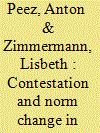| Srl | Item |
| 1 |
ID:
185245


|
|
|
|
|
| Summary/Abstract |
Elephants and whales took center stage in the environmental movements of the 1980s. As flagship species, they were the poster children of global initiatives: international ivory trading and commercial whaling were banned in the 1980s in the context of the Convention on International Trade in Endangered Species of Wild Fauna and Flora (CITES) and the International Whaling Commission (IWC), respectively. While the conservation of both species is contested, we observe a change of existing norms in one case but not in the other: A moratorium on commercial whaling remains in place. Meanwhile, a limited shift to sustainable use regarding ivory was passed in 1997/2000. We ask why norm change occurred in one case but not the other, given their similarities. We argue that the difference can be explained by the perceived legitimacy of the claims of norm challengers using arguments of “affectedness” and the breadth of issues covered by CITES. In contrast, other factors commonly discussed in norms research do not explain this puzzle: the relative power and strategies of norm advocates and challengers, and the degree of legalization. This shows the interplay of discursive aspects and concrete institutional opportunities for norm change, even in the face of otherwise inopportune conditions.
|
|
|
|
|
|
|
|
|
|
|
|
|
|
|
|
| 2 |
ID:
183243


|
|
|
|
|
| Summary/Abstract |
Wildlife trade policies in China and elsewhere have come under increased scrutiny following suggestions that the emergence of the coronavirus SARS-CoV-2 may have been linked to trade in wild animals. The breeding of and trade in most terrestrial wild animal species for consumption as food were prohibited in China in February 2020, but trade for non-food purposes such as ornamental items or traditional medicine continues to be covered by provisions in the Wildlife Protection Law (WPL). While a superficial reading of the WPL could lead to the conclusion that commercial trade in nationally protected species is generally prohibited, in practice key language is interpreted to permit commercial trade in the parts and derivatives of protected wild animal species, including those subject to the most stringent protection within China and internationally, such as leopards and pangolins.
|
|
|
|
|
|
|
|
|
|
|
|
|
|
|
|
| 3 |
ID:
166579


|
|
|
|
|
| Summary/Abstract |
This article seeks to determine why the illegal wildlife trade is still flourishing in China despite the country’s adoption of the Convention on International Trade in Endangered Species of Wild Flora and Fauna (CITES). It focuses on the 1989 international trade ban on African elephant ivory. Taking a normative social constructivist approach, the article illuminates the motivations for, and processes and consequences of, accommodating novel norms in domestic situations. In addition, China is compared with Japan to ensure both methodological rigour and wide empirical coverage. It is argued that, although species protection has been adopted as a legitimate transnational norm, it has not been sufficiently socialized into Chinese (or Japanese) society. Rather, related local issues and social, cultural and economic factors play crucial roles in driving ivory demand and trade. Thus, despite the adoption of a relevant regulatory framework, illegal wildlife trade has become a serious problem in today’s highly commercialized Chinese (and Japanese) society. This problem can be solved only by conforming to international conservation norms and implementing stringent regulations and effective governance.
|
|
|
|
|
|
|
|
|
|
|
|
|
|
|
|